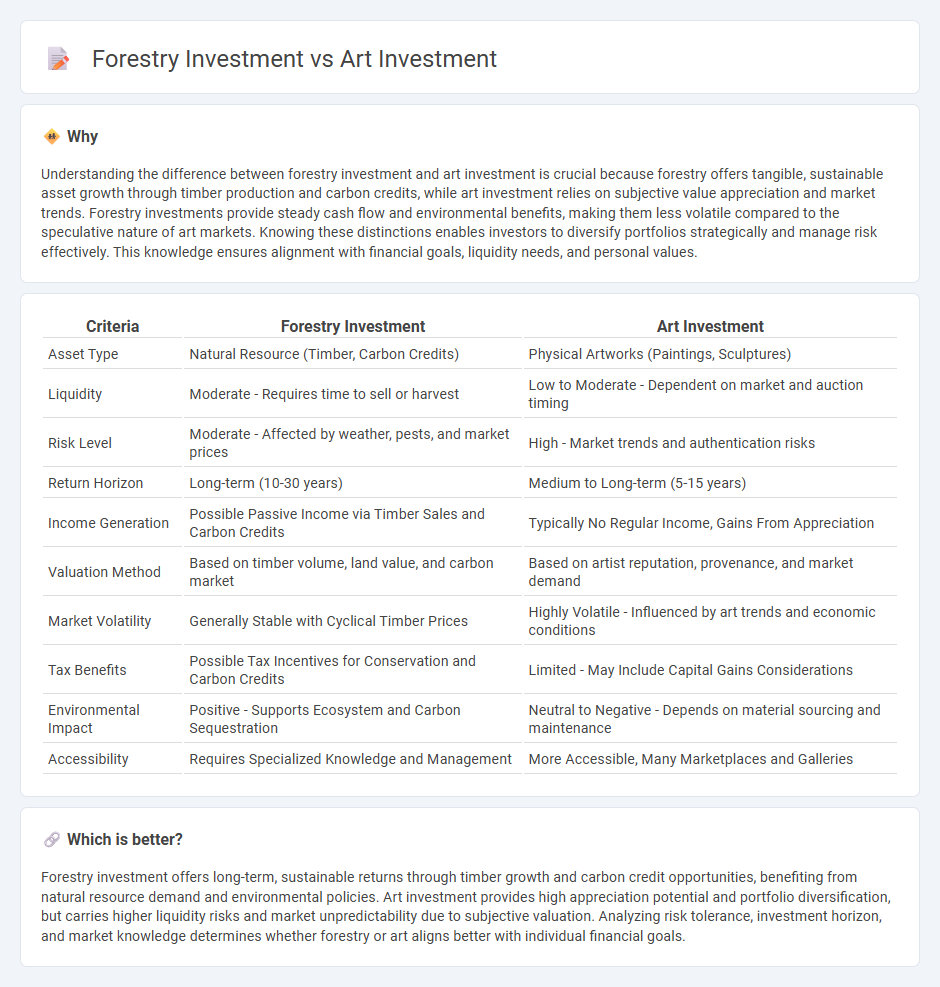
Forestry investment offers long-term sustainable returns through timber growth and carbon credits, appealing to eco-conscious investors seeking asset diversification with environmental impact. Art investment provides potential high appreciation and portfolio enrichment, leveraging market demand for rare and culturally significant works while requiring expertise in valuation. Discover deeper insights into how forestry and art investments can align with your financial goals.
Why it is important
Understanding the difference between forestry investment and art investment is crucial because forestry offers tangible, sustainable asset growth through timber production and carbon credits, while art investment relies on subjective value appreciation and market trends. Forestry investments provide steady cash flow and environmental benefits, making them less volatile compared to the speculative nature of art markets. Knowing these distinctions enables investors to diversify portfolios strategically and manage risk effectively. This knowledge ensures alignment with financial goals, liquidity needs, and personal values.
Comparison Table
| Criteria | Forestry Investment | Art Investment |
|---|---|---|
| Asset Type | Natural Resource (Timber, Carbon Credits) | Physical Artworks (Paintings, Sculptures) |
| Liquidity | Moderate - Requires time to sell or harvest | Low to Moderate - Dependent on market and auction timing |
| Risk Level | Moderate - Affected by weather, pests, and market prices | High - Market trends and authentication risks |
| Return Horizon | Long-term (10-30 years) | Medium to Long-term (5-15 years) |
| Income Generation | Possible Passive Income via Timber Sales and Carbon Credits | Typically No Regular Income, Gains From Appreciation |
| Valuation Method | Based on timber volume, land value, and carbon market | Based on artist reputation, provenance, and market demand |
| Market Volatility | Generally Stable with Cyclical Timber Prices | Highly Volatile - Influenced by art trends and economic conditions |
| Tax Benefits | Possible Tax Incentives for Conservation and Carbon Credits | Limited - May Include Capital Gains Considerations |
| Environmental Impact | Positive - Supports Ecosystem and Carbon Sequestration | Neutral to Negative - Depends on material sourcing and maintenance |
| Accessibility | Requires Specialized Knowledge and Management | More Accessible, Many Marketplaces and Galleries |
Which is better?
Forestry investment offers long-term, sustainable returns through timber growth and carbon credit opportunities, benefiting from natural resource demand and environmental policies. Art investment provides high appreciation potential and portfolio diversification, but carries higher liquidity risks and market unpredictability due to subjective valuation. Analyzing risk tolerance, investment horizon, and market knowledge determines whether forestry or art aligns better with individual financial goals.
Connection
Forestry investment and art investment share similarities in long-term value appreciation and portfolio diversification, appealing to investors seeking alternative assets. Both sectors offer tangible assets that hedge against inflation and economic volatility, with forestry investments providing sustainable returns through timber growth and carbon credits, while art investments capitalize on cultural value and rarity. Strategic allocation to forestry and art enhances risk-adjusted returns by combining ecological assets and creative capital in diversified investment strategies.
Key Terms
Art Investment:
Art investment offers a unique blend of aesthetic appreciation and financial potential, with artworks often appreciating in value due to rarity, artist reputation, and market trends. Unlike forestry investment, which depends on biological growth cycles and commodity prices, art investment benefits from cultural shifts and limited supply, making it a dynamic asset class. Explore the nuances of art investment strategies and artist market analysis to maximize returns and portfolio diversification.
Provenance
Art investment offers unique provenance through documented history and authenticity, enhancing the artwork's value and appeal to collectors. Forestry investment relies on transparent provenance via geographic location, ecosystem sustainability, and legal land ownership, ensuring environmental and financial credibility. Explore the detailed benefits and risks of provenance in these investment types to make informed decisions.
Liquidity
Art investment typically offers lower liquidity compared to forestry investment due to the niche market and longer sales cycle involved in art transactions. Forestry investments benefit from more predictable cash flow through timber sales and can potentially be liquidated through land or asset sales, though they also require significant holding periods for optimal returns. Explore deeper insights on liquidity dynamics between art and forestry investments to make informed decisions.
Source and External Links
Basics of Art Funds and their Managers , The Art Fund Association - Art investment funds typically employ strategies like buy and hold, geographic arbitrage, and focus on specific artists or periods, offering portfolio diversification, inflation hedging, and return potential with unique arbitrage opportunities due to the art market's regulation scarcity.
Investing in art: What to know about turning a passion into a ... - Art investment carries risks such as lack of liquidity, condition maintenance, and market trend volatility, yet it can diversify portfolios, protect against inflation, and yield cultural returns alongside financial gains.
How to Invest in Art: A Seven-Point Guide to Help You Understand ... - Art often outperforms other passion investments due to its limited supply, cultural significance, and tangibility, requiring relatively low maintenance and offering sustained value appreciation over time.
 dowidth.com
dowidth.com